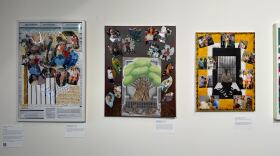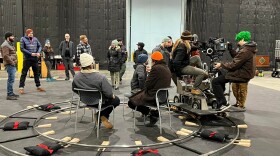Where does the creativity come from that fuels a work of art?
For Seattle woodcarver Daniel Webb, it comes from the dialogue he has with centuries-old wood as he carves into them.
Webb uses mostly reclaimed wood, much of it more than 200 years old. His first solo exhibition opens today at Bellevue Arts Museum, where you can see how he transforms discarded stumps and I-beams into objects as delicate as a shimmering balloon, a wispy dandelion or child’s pillow.
‘You’re A Little Scared Every Time You Cut Into One Of These Things’
On a recent day inside his studio in Seattle’s Georgetown neighborhood, Webb started up a small electric chainsaw and pressed it gently into the side of a big stump someone delivered from a family property on Whidbey Island.
As the sawdust sprinkled onto his boots, he paused to smell the air and looked at the bark he was left holding. He says he doesn’t usually work with that part of the wood.
“Though maybe I should,” he joked, admiring its texture. “Come back in a month, maybe I’ll have this done.”

Sitting next to the stump was a 5 foot-tall rectangular piece of old-growth fir. Based on its growth rings and wood grain, Webb estimates it’s about 250 years old. And it’s less than a quarter of the original tree, which must have had a diameter of at least 6 feet across. He admits, starting in on a piece can be intimidating.
“You’re a little scared every time you cut into one of these things. I mean, it should be done with a certain amount of respect for sure,” he said.
Most of the time he proceeds slowly, using a mallet and chisels and files — as many as fifty different kinds, he says — as he explores the substance of a new piece of wood.

To demonstrate, he tapped into a small chunk of lime wood that someone brought him back from Europe. He says it feels like a bar of soap; he’s used to working with much harder materials that many carvers wouldn’t touch, like knotty pine.
"But really, 80 percent of the time, this is what my studio mates are hearing,” he said, as his work made a tap-tap-tap sound.
Right now, his studio is mostly empty. Almost everything he owns is on display at the Bellevue Arts Museum.
Webb’s Distinctive Pieces

Featured in centerfold of the show’s catalogue is an image of a piece Webb carved last year, called “Cut Flamed Spalted.” It’s an amazingly realistic life-sized arm, reaching out to the viewer. It’s hinged to the cut-out block that it came from, which still has lots of rough grooves. But the arm is sanded so smoothly, it looks like skin. And its surface is almost translucent and riddled with woody ripples and black lines. Webb says those are evidence of hardships faced by the original tree.
“And the way that a maple tree overcomes those hardships is really beautiful,” he said. “Flamed grain is just this amazing kind of grain that looks rippled and three dimensional. And spalt is a kind of fungus that the tree surrounds with this black shell. And when you carve it, it looks like a tattoo.”
The piece's intricacies are not lost on Nora Atkinson, the curator of the show at Bellevue Arts Museum. She says that piece, one of her favorites of Webb’s, is based on a famous 18th-century painting by Jaques-Louis David, of a man in a bath with his arm hanging out of the tub.
“’The Death of Marat.’ And so you see that same gesture in the arm, as it’s laying there, lifeless. But it’s also a little ambiguous. It doesn’t necessarily play as a death scene when you look at it,” she said.

The oldest piece in the show, from 1999, is simply called “Desk.” Something colorful and waxy is dripping from beneath its squished and angular form. Atkinson it’s a good example of Webb’s more whimsical side.
“It’s got this gum that’s sort of wadded up on the underside of a hand-built wooden desk, like this child has been sitting in class all day, bored and daydreaming,” she said.
There’s also a slumping knight called “Mr. Fixit,” made entirely of duct tape. Then there’s a pillow with a fresh imprint that makes you think about the person whose head must have been there a few seconds ago.

“Fragile Fortress,” shows a wooden blanket with children’s shoes peeking out from beneath a mound of wooden blankets. And there are two wooden heads called “Stretch” and “Squeeze” that look more like silly putty.
At the center of it all is a large piece called “Woodylion.” Atkinson says it’s part of a series of images of very fragile-looking dandelions. Its flower shoots up, spindly and raw, from a burned and blackened block of redwood.
“He’s carved out of a single block of wood this little stalk of a dandelion that’s coming up out of the top. And then, as you look down at the very bottom of the piece, you see the roots coming out of the bottom. It’s so delicate,” she said.
He makes a common weed look like almost like an endangered species. Webb says that tension is not by accident; he sees the dandelion as an underdog that follows human activity and survives in spite of us.
“And I think it does so with this kind of beautiful aplomb. You know, who hasn’t taken one of those puffball, seed balls of a dandelion and blown it by the millions off into the air to be seeded somewhere else? You know, it’s such a great design solution,” he said.
‘It’s A Game Of Inches’

Webb says he’s not sure how long it took him to carve “Woodylion,” which, like most of his works, is shaped by flaws in the wood, including a crack in the top of the block that slowed his progress. He says it was weeks or maybe months; he’s learned you just have to show up and do the work.
“It’s a game of inches, and I just realize that I can’t focus on how long it’s taking, so I don’t anymore. I just focus on seeing that thing appear,” he said.
He says in the beginning, it’s nebulous and almost invisible. But after a day or two, something snaps into place and he can see his idea materializing in his hands.
“And that’s always really exciting, you know? It is really hard to stop when you get to that point. And you know, you earn these things. So by the time you get to see it, there’s just this amazing elation. You’re just so excited, you know, [you're thinking,] ‘What’s it going to be? I hope it turns out!’” he said.
Up to that very last day, Webb says, something could slip or break apart. He finishes about five or six pieces of work per year.
Webb’s iconic pieces from the past 15 years are included in the show at the Bellevue Arts Museum, which continues through June 15.








